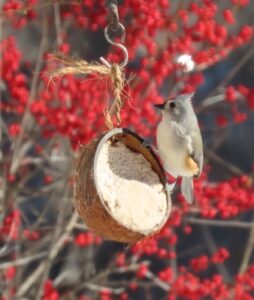Have fun counting birds and helping NH Audubon at the same time. Take part in the annual Backyard Winter Bird Survey on Saturday, February 10, and Sunday, February 11. Biologists need assistance from people all over the Granite State to get a clear picture of what is happening with our winter birds.
This past fall, many people remarked that the birds disappeared from their feeders. Are they back? NH Audubon wants to know. All New Hampshire residents are encouraged to take part. Anyone can participate in the Survey by counting the birds in their own backyard on the Survey weekend and reporting online or sending the results on a special reporting form to NH Audubon. To receive a copy of the reporting form and complete instructions, email your name and address to bwbs@nhaudubon.org or call 603-224-9909. Forms are also available on-line or results can be submitted online. Find more information about the survey here.

As for those empty feeders in the fall, there’s probably nothing to worry about. An excellent crop of natural foods including berries, seeds, and White Pine cones combined with a mild fall, meant that our local birds had lots to eat in the woods and fields. NH Audubon biologists believe that is why the birds were not at the feeders this fall, but it’s the results from the Survey that will help them determine if anything else might be going on with our resident birds. “Standardized results from across the state really help us see patterns of ups and downs in bird populations,” said NH Audubon’s Dr. Pamela Hunt. “Being able to look at long term trends is key to finding declining species.”
Each year 1,500 observers or more across the state count the birds coming to their feeders. Reports of a lack of birds are just as valuable as reports of many birds. “If everyone reported only when they have a lot of birds, we wouldn’t be able to see the declines,” says Rebecca Suomala, Survey Coordinator. The most important thing is to participate each year regardless of how many or how few birds you have. Data from the Backyard Winter Bird Survey help biologists track changes in the distribution and abundance of our year round resident birds. Results from past years can be found on the website.
